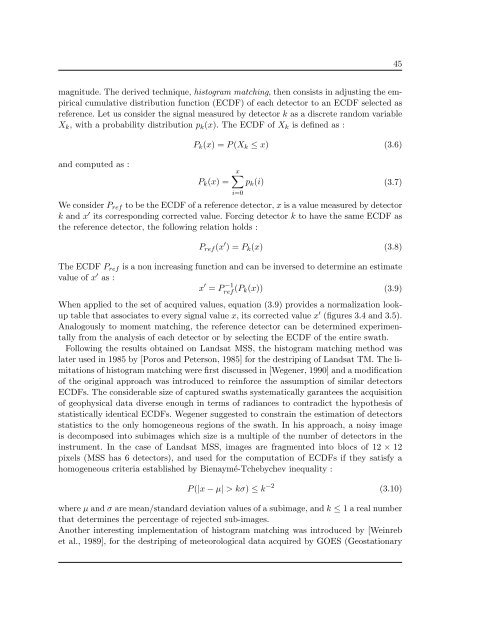Th`ese Marouan BOUALI - Sites personnels de TELECOM ParisTech
Th`ese Marouan BOUALI - Sites personnels de TELECOM ParisTech
Th`ese Marouan BOUALI - Sites personnels de TELECOM ParisTech
Create successful ePaper yourself
Turn your PDF publications into a flip-book with our unique Google optimized e-Paper software.
45<br />
magnitu<strong>de</strong>. The <strong>de</strong>rived technique, histogram matching, then consists in adjusting the empirical<br />
cumulative distribution function (ECDF) of each <strong>de</strong>tector to an ECDF selected as<br />
reference. Let us consi<strong>de</strong>r the signal measured by <strong>de</strong>tector k as a discrete random variable<br />
X k , with a probability distribution p k (x). The ECDF of X k is <strong>de</strong>fined as :<br />
and computed as :<br />
P k (x) =P (X k ≤ x) (3.6)<br />
P k (x) =<br />
x∑<br />
p k (i) (3.7)<br />
We consi<strong>de</strong>r P ref to be the ECDF of a reference <strong>de</strong>tector, x is a value measured by <strong>de</strong>tector<br />
k and x ′ its corresponding corrected value. Forcing <strong>de</strong>tector k to have the same ECDF as<br />
the reference <strong>de</strong>tector, the following relation holds :<br />
i=0<br />
P ref (x ′ )=P k (x) (3.8)<br />
The ECDF P ref is a non increasing function and can be inversed to <strong>de</strong>termine an estimate<br />
value of x ′ as :<br />
x ′ = P −1<br />
ref (P k(x)) (3.9)<br />
When applied to the set of acquired values, equation (3.9) provi<strong>de</strong>s a normalization lookup<br />
table that associates to every signal value x, its corrected value x ′ (figures 3.4 and 3.5).<br />
Analogously to moment matching, the reference <strong>de</strong>tector can be <strong>de</strong>termined experimentally<br />
from the analysis of each <strong>de</strong>tector or by selecting the ECDF of the entire swath.<br />
Following the results obtained on Landsat MSS, the histogram matching method was<br />
later used in 1985 by [Poros and Peterson, 1985] for the <strong>de</strong>striping of Landsat TM. The limitations<br />
of histogram matching were first discussed in [Wegener, 1990] and a modification<br />
of the original approach was introduced to reinforce the assumption of similar <strong>de</strong>tectors<br />
ECDFs. The consi<strong>de</strong>rable size of captured swaths systematically garantees the acquisition<br />
of geophysical data diverse enough in terms of radiances to contradict the hypothesis of<br />
statistically i<strong>de</strong>ntical ECDFs. Wegener suggested to constrain the estimation of <strong>de</strong>tectors<br />
statistics to the only homogeneous regions of the swath. In his approach, a noisy image<br />
is <strong>de</strong>composed into subimages which size is a multiple of the number of <strong>de</strong>tectors in the<br />
instrument. In the case of Landsat MSS, images are fragmented into blocs of 12 × 12<br />
pixels (MSS has 6 <strong>de</strong>tectors), and used for the computation of ECDFs if they satisfy a<br />
homogeneous criteria established by Bienaymé-Tchebychev inequality :<br />
P (|x − µ| > kσ) ≤ k −2 (3.10)<br />
where µ and σ are mean/standard <strong>de</strong>viation values of a subimage, and k ≤ 1 a real number<br />
that <strong>de</strong>termines the percentage of rejected sub-images.<br />
Another interesting implementation of histogram matching was introduced by [Weinreb<br />
et al., 1989], for the <strong>de</strong>striping of meteorological data acquired by GOES (Geostationary















